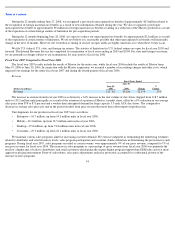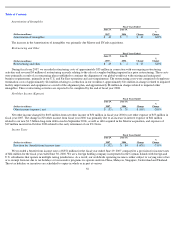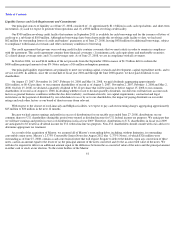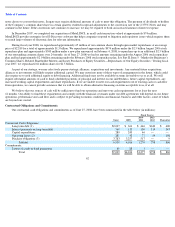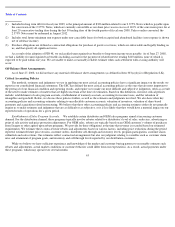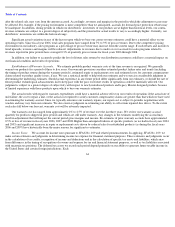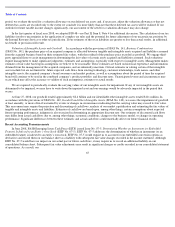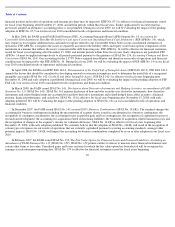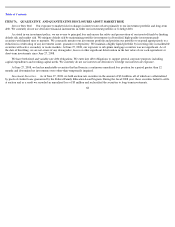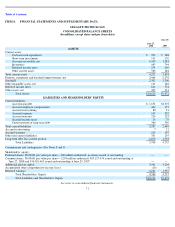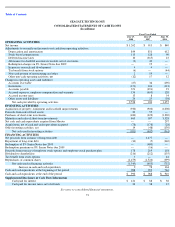Seagate 2007 Annual Report Download - page 65
Download and view the complete annual report
Please find page 65 of the 2007 Seagate annual report below. You can navigate through the pages in the report by either clicking on the pages listed below, or by using the keyword search tool below to find specific information within the annual report.
Table of Contents
after the related sale, may vary from the amount accrued. Accordingly, revenues and margins in the period in which the adjustment occurs may
be affected. For example, if the pricing environment is more competitive than we anticipated, accruals for forward price protection rebates may
be inadequate. In addition, during periods in which our distributors’ inventories of our products are at higher than historical levels, our contra-
revenue estimates are subject to a greater degree of subjectivity and the potential for actual results to vary is accordingly higher. Currently, our
distributors’ inventories are within the historical range.
Significant actual variations in any of the factors upon which we base our contra-revenue estimates could have a material effect on our
operating results. Since fiscal year 2006, total sales programs have ranged from 7% to 9% of gross revenues. Due to the competitive pricing
environment in our industry, sales programs as a percentage of gross revenue may increase from the current range. If such rebates and incentives
trend upwards, revenues and margins will be reduced. Adjustments to revenues due to under or over accruals for sales programs related to
revenues reported in prior periods have averaged 0.3% of quarterly gross revenue for fiscal years 2006 through 2008.
In addition, our failure to accurately predict the level of future sales returns by our distribution customers could have a material impact on
our financial condition and results of operations.
Establishment of Warranty Accruals. We estimate probable product warranty costs at the time revenue is recognized. We generally
warrant our products for a period of three to five years. Our warranty provision considers estimated product failure rates and trends (including
the timing of product returns during the warranty periods), estimated repair or replacement costs and estimated costs for customer compensatory
claims related to product quality issues, if any. We use a statistical model to help with our estimates and we exercise considerable judgment in
determining the underlying estimates. Should actual experience in any future period differ significantly from our estimates, or should the rate of
future product technological advancements fail to keep pace with the past, our future results of operations could be materially affected. Our
judgment is subject to a greater degree of subjectivity with respect to newly introduced products and legacy Maxtor designed products because
of limited experience with those products upon which to base our warranty estimates.
The actual results with regard to warranty expenditures could have a material adverse effect on our results of operations if the actual rate of
unit failure, the cost to repair a unit, or the actual cost required to satisfy customer compensatory claims are greater than that which we have used
in estimating the warranty accrual. Since we typically outsource our warranty repairs, our repair cost is subject to periodic negotiations with
vendors and may vary from our estimates. We also exercise judgment in estimating our ability to sell certain repaired disc drives. To the extent
such sales fall below our forecast, warranty cost will be adversely impacted.
Our warranty cost has ranged from approximately 2% to 2.5% of revenue over the last three years. We review our warranty accrual
quarterly for products shipped in prior periods and which are still under warranty. Any changes in the estimates underlying the accrual may
result in adjustments that will impact the current period gross margins and income. Re-estimates of prior warranty accruals have approximated
0.5% or less of revenue in fiscal years 2006, 2007 and 2008. Higher than anticipated failures of specific products (as we had in fiscal years 2004
and 2005) and significant increases in repair or replacement costs driven by reduced sales for refurbished products (as during the fiscal years
2006 and 2007) have historically been the major reasons for significant re-estimates.
Income Taxes. We account for income taxes pursuant to SFAS No. 109 and related pronouncements. In applying, SFAS No. 109, we
make certain estimates and judgments in determining income tax expense for financial statement purposes. These estimates and judgments occur
in the calculation of tax credits, recognition of income and deductions and in the calculation of specific tax assets and liabilities, which arise
from differences in the timing of recognition of revenue and expense for tax and financial statement purposes, as well as tax liabilities associated
with uncertain tax positions. The deferred tax assets we record each period depend primarily on our ability to generate future taxable income in
the United States and certain foreign jurisdictions. Each
64


